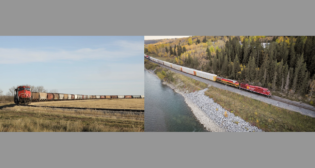
Railroads at Midyear: New gains, new challenges
Written by AdministratorEver since Warren Buffett gave his blessing to railroads by buying one, financial analysts and pundits have been examining this 175-year-old industry for clues to its re-emergence as a savvy investor’s favorite.
Wall Street Journal “Common Sense” columnist James B. Stewart addressed the question last month when he selected Norfolk Southern as one of “Five Stocks to Own Forever.” After extolling the attractiveness of such other picks as Google and Oracle, Stewart explained his choice of a railroad for the charmed circle:
“An old-fashioned railroad may seem stodgy in this group, but think about it. Who’s building any new ones? Railroads enjoy large-scale economies of scale and offer cheaper alternatives than truck and air delivery, particularly in the heavily congested eastern half of the U.S., where Norfolk Southern operates. Its results are sensitive to the economic cycle, especially demands for the raw materials it handles so cost-effectively. But we’re still in the early stages of what could be a long-term recovery, from which Norfolk Southern should benefit. I wouldn’t expect a railroad to end up among my top 10 performing stocks of the year list, but when it comes to the long term, slow, and steady growth is fine with me.”
That pretty much sums up the state of the railroads at mid-year 2011: an irreplaceable industry with the strong fundamentals that have made it a growth industry as it approaches a third century of operation. Even as they face new challenges on reregulation and confront, with the rest of American industry, an economy weakened by global business trends, the railroads continue to show strength. Because they offer shippers some significant advantages over trucking—particularly in pricing—they’ve been able to adjust rates upward (see Contributing Editor Larry Kaufman’s sidebar, p. 16). They continue to pour investment capital into new intermodal facilities (see Contributing Editor Jason Seidl’s analysis, p 18).
The most recently available operating and financial statistics from the Surface Transportation Board demonstrate their earning power over the long term. For the 12-month period through the end of this year’s first quarter, U.S. Class I railroads increased their operating revenues 22%, compared to the prior 12 months; they improved their net railway operating income by 33%; and their net income climbed 35%. The second half of 2011 is shaping up as one of continued steady growth.
Protecting shippers or hindering railroads?
On June 22—largely at the urging of Senate Commerce Committee Chair Sen. Jay Rockefeller (D-W.Va.), a strong proponent of reregulation—the Surface Transportation Board convened to address rail competition concerns raised by a small number of captive shippers. Speakers testifying on the subject included shippers from numerous industries, railroads, legislators, and industry experts. Wall Street investment firm Dahlman Rose & Co. provided the following analysis:
“The STB hearings provided few answers to the long standing fight between some captive shippers and the rail industry. We believe that rail shippers appear to be largely unified on what they describe as the problem of unchecked rail pricing power, stemming from the lack of competition, especially in cases of captive shippers. However, we do not believe a consensus opinion exists on proposed solutions or how such solutions should be implemented. That said, most shippers are in agreement regarding certain broad concepts. They believe that greater reciprocal switching should lead to increased competition in the railroad industry but they insist that they are not demanding full open access. It is our opinion that the lack of clarity could prove to be a hindrance to the efforts of the STB, which appears otherwise eager to lead the parties to a middle-ground resolution. Hence, the likelihood of further studies by the STB on specific issues exists.
“Several shippers asserted that rail competition practically disappeared after 2003-2004, especially in situations where shippers are geographically captive to a single carrier. Such shippers say that, over the last several years, they have had to deal with unreasonably high rail price increases (even during the 2009 recession-triggered precipitous decline in volumes), while service continued to deteriorate. Some described a take-it-or-leave-it attitude adopted by the railroads in contract negotiations with captive shippers.
“Michael McBride, who was on the Interested Parties pro-shipper panel, suggested that even captive shippers who may be larger and more resourceful than their sole rail carriers have failed to obtain reasonable rates in a monopolistic environment. He pointed out that captive shippers exist in many industries, such as coal, chemicals, cement, crushed stone, and agricultural products. Many of these industries, he argued, are critical for the domestic economy and job creation.
“Meanwhile, intermodal shippers, many of whom have operations overseas with relatively limited contributions to the U.S. economy, tend to enjoy more competitive rates from the railroads. We note that such attractive rates are largely the product of the existence of truck competition in intermodal lanes. While truck competition exists for the aforementioned bulk commodities, it is not nearly as prevalent as it is in the intermodal space.
“In his comment before the board, Sen. Rockefeller, who is perhaps the most outspoken critic of freight railroads, called for prompt action to protect shippers from unchecked rail pricing. He expressed his disappointment in the STB’s lack of action, stating bluntly that ‘the STB has let us down’ in the past. While he is a staunch advocate of new legislation that would address the issue, he admitted that Congress is currently ‘not functioning’ and that a legislative remedy is unlikely to materialize in the foreseeable future.
“As such, the Senator placed the immediate burden on the STB, an administrative agency, to draft new rules and processes for helping shippers. He also cautioned against an all-or-nothing approach, indicating that, in absence of radical reform, incremental changes should help. We believe that Rockefeller lost his chance to enact legislation and that he views the STB as the only way to ensure that his long standing feud with the rail industry will not be remembered by historians as a failure.
“Some witnesses spoke out in support of the rail industry, noting that they are all private firms that essentially pay their own way. Ed Hamberger, President and CEO of the Association of American Railroads, spoke out on behalf of the railroads, emphasizing that railroads own and operate their own lines, investing entirely their own capital. Proponents warned that if these private rail networks are infringed upon, they may be forced to cut back. Cutbacks could include anything, from personnel cuts to a diminished network of rail lines.
“In our opinion, severe cutbacks could represent serious implications for a domestic supply chain that is already under the strain of severe highway congestion in major metropolitan areas. Testimony pointed out that railroads run the most environmentally-friendly form of transportation, and we should be investing in them, not hindering them. Speakers conveyed that railroads are poised to address the current transportation needs of the country, and any limitations placed on them may impact the country’s productive supply chain. One final point made was that if there are any changes to come out of the STB, they would only result in a short term transfer of revenue, and would not address long-term concerns.
“Due to the apparent lack of a well-defined approach to address rail pricing that would suit all shippers, the unlikely passage of new Congressional legislation that would fortify the STB and create new laws in the industry, and the existence of current venues through which shippers can take rate action against the railroads, we believe it is unlikely that radical steps would be taken in the foreseeable future by regulators.
“That said, the STB could embark on any number of small initiatives to placate shippers, including the establishment of more speedy arbitration processes. Accordingly, we believe that the hearings pose low risk to the railroads and would view any market overreaction as a potential entry point to our Buy-rated stocks.”
In his testimony before the STB, UP chief executive Jim Young offered compelling evidence that competition—not the lack of it—drives virtually everything railroads do:
“Shippers proposing new access remedies say they are trying to increase competition. But railroads are already subject to intense competition. Each year, we lose and must replace over 10% of our business. We continually struggle with other railroads, trucks, and water carriers to win and retain business.
“You cannot measure competition by looking only at rates or rate computations. You also have to look at the value we provide. Similarly, you cannot just look at whether traffic shifts between carriers. If our service creates enough value for our customers, they keep their business with us, give us more business, and are willing to pay for the value we provide.
“Competition is what drives us to invest. It’s why we poured $30 billion of capital into our network from 1999 through 2010. It’s why we plan to spend $3.3 billion this year, $1.9 billion to replace and renew existing assets, and over a billion for new growth capacity. This is the highest capital spent in the history of our company.
“Competition is why we have committed to investing 17 to 18% of revenue annually over the next several years—assuming the regulatory environment will allow us the opportunity to earn adequate financial returns.
“In short, competition is why we devote so much of our creativity, energy, and resources to improving service and expanding our network. As our earnings have grown, so have our investments. We can’t afford to ignore our customers. And our customers—at least most of them—recognize our efforts.
“Proponents of new access remedies are not seeking more competition, they want policies that will shift revenue from railroads to shippers. These policies will also have the unintended consequence of increasing our operating costs, eliminating efficiencies, and consuming network capacity.
The Kohl factor
The industry’s other regulatory battle involves an attempt to repeal the railroads’ limited anti-trust exemptions. In the Senate, Herb Kohl (D-Wisc.), chairman of the Senate Judiciary Committee, Subcommittee on Antitrust, Competition Policy, and Consumer Rights, is sponsoring S.49, the Railroad Antitrust Enforcement Act.” The bill is described as “legislation to remove obsolete antitrust exemptions protecting the freight railroad industry, exemptions that eliminate the ability of those aggrieved by anti-competitive practices or transactions to obtain antitrust remedies.”
In a letter to Congress last month, the AAR, American Short Line and Regional Railroad Association, and Railway Supply Institute strongly urged the legislative body to reject the “Kohl Bill”: “Railroads are already generally subject to the same antitrust laws as other businesses. The limited exemptions that the railroads do have exist only where the STB regulates the same matter or activity. There is no gap in government regulatory oversight. Going beyond the antitrust laws, the bill limits the application to the railroads of the judicial doctrine that allows the courts to defer to the primary jurisdiction of an administrative agency on matters that are within the agency’s areas of expertise and oversight. This doctrine is common for all regulated industries and for all legal matters. However, S.49 singles out the railroads for hostile treatment in a manner that has nothing to do with antitrust exemption.”
(Senior Consulting Editor Luther S. Miller contributed to this article.)



